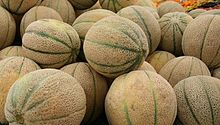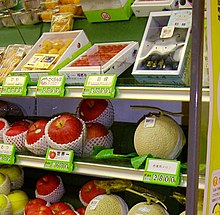Cantaloupe
| Cantaloupe | |
|---|---|

| |
| Scientific classification | |
| Kingdom: | |
| (unranked): | |
| (unranked): | |
| (unranked): | |
| Order: | |
| Family: | |
| Genus: | |
| Species: | |
| Subspecies: | C. melo subsp. melo
|
| Variety: | C. melo var. cantalupo
|
| Trinomial name | |
| Cucumis melo var. cantalupo[1] | |
| Synonyms[1] | |
| |
Cantaloupe (also cantelope, cantaloup, muskmelon (India and the United States), mushmelon, rockmelon, sweet melon, honeydew, Persian melon, or spanspek (South Africa)) refers to a variety of Cucumis melo, a species in the family Cucurbitaceae.
Cantaloupes range in weight from 0.5 to 5 kilograms (1.1 to 11.0 lb). Originally, cantaloupe referred only to the non-netted, orange-fleshed melons of Europe.[2] However, in more recent usage, it has come to mean any orange-fleshed melon (C. melo) and is the most popular variety of melon in North America.[2]
Etymology
The name is derived via French from Italian Cantalupo which was formerly a papal county seat near Rome after introduction from Armenia.[3] It was first mentioned in English literature in 1739.[2]
Origin
The cantaloupe most likely originated in a region from Iran to India and Africa.[2] It was later introduced to Europe and, around 1890, became a commercial crop in the United States.[2]
Description

The European cantaloupe is lightly ribbed, with a sweet and flavorful flesh and a gray-green skin that looks quite different from that of the North American cantaloupe.[2]
The North American cantaloupe, common in the United States, Mexico, and in some parts of Canada, is actually a muskmelon, a different variety of Cucumis melo, and has a net-like (or reticulated) skin covering.[2] It is a round melon with firm, orange, moderately sweet flesh and a thin, reticulated, light-brown rind.[2] Varieties with redder and yellower flesh exist, but are not common in the US market.[citation needed]
Production
In 2013, world production of melons, including cantaloupes, was 29.4 million tonnes, with China accounting for 49% of the total (14.4 million tonnes).[4] Other significant producers in 2013 were Turkey, Iran, Egypt and India (range of 1.7 to 1 million tonnes).[4]
Uses


Because they are descended from tropical plants and tend to require warm temperatures throughout a relatively long growing period, cantaloupes grown in temperate climates are frequently started indoors for 14 days or longer before being transplanted outdoors.
Cantaloupes are often picked, and shipped, before fully ripening. Postharvest practices include treatment with a sodium hypochlorite or bleach wash to prevent mold and Salmonella growth. This treatment, because it can mask the melon's musky aroma, can make it difficult for the purchaser to judge the relative quality of different cantaloupes.
Cantaloupe is normally eaten as a fresh fruit, as a salad, or as a dessert with ice cream or custard. Melon pieces wrapped in prosciutto are a familiar antipasto.
Because the surface of a cantaloupe can contain harmful bacteria—in particular, Salmonella[5]—it is recommended to wash and scrub a melon thoroughly before cutting and consumption. The fruit should be refrigerated and consumed less than three days after cutting to prevent risk of Salmonella or other bacterial pathogens.[6]
A moldy cantaloupe in a Peoria, Illinois market in 1943 was found to contain the highest yielding strain of mold for penicillin production, after a worldwide search.[7]
Nutrition
 Cantaloupe in cross-section | |||||||||||||||||||||||||||||||||||||||||||||||||
| Nutritional value per 100 g (3.5 oz) | |||||||||||||||||||||||||||||||||||||||||||||||||
|---|---|---|---|---|---|---|---|---|---|---|---|---|---|---|---|---|---|---|---|---|---|---|---|---|---|---|---|---|---|---|---|---|---|---|---|---|---|---|---|---|---|---|---|---|---|---|---|---|---|
| Energy | 141 kJ (34 kcal) | ||||||||||||||||||||||||||||||||||||||||||||||||
8.16 g | |||||||||||||||||||||||||||||||||||||||||||||||||
| Sugars | 7.86 g | ||||||||||||||||||||||||||||||||||||||||||||||||
| Dietary fiber | 0.9 g | ||||||||||||||||||||||||||||||||||||||||||||||||
0.19 g | |||||||||||||||||||||||||||||||||||||||||||||||||
0.84 g | |||||||||||||||||||||||||||||||||||||||||||||||||
| |||||||||||||||||||||||||||||||||||||||||||||||||
| Other constituents | Quantity | ||||||||||||||||||||||||||||||||||||||||||||||||
| Water | 90.2 g | ||||||||||||||||||||||||||||||||||||||||||||||||
| †Percentages estimated using US recommendations for adults,[8] except for potassium, which is estimated based on expert recommendation from the National Academies.[9] | |||||||||||||||||||||||||||||||||||||||||||||||||
Raw cantaloupe is 90% water, 8% carbohydrates, 0.8% protein and 0.3% fat, providing 34 Calories (kcal) and 2020 mg of the provitamin A orange carotenoid, beta-carotene per 100 gram amount (table). Fresh cantaloupe is an excellent source (20% or more of the Daily Value, DV) of vitamin C (44% DV) and vitamin A (21% DV), with other nutrients in negligible content (less than 10% DV) (table).
References
- ^ a b "Taxon: Cucumis melo L. subsp. melo var. cantalupo Ser". Germplasm Resources Information Network (GRIN). United States Department of Agriculture, Agricultural Research Service, Beltsville Area. Retrieved 2010-12-09.
- ^ a b c d e f g h Cantaloupe in Foods & Nutrition Encyclopedia, 2nd Edition, Volume 1. CRC Press. 1993. pp. 329–331. ISBN 084938981X.
{{cite book}}: Unknown parameter|authors=ignored (help) - ^ "Cantaloupe". Oxford English Dictionary. 2016. Retrieved 26 January 2016.
{{cite web}}: Italic or bold markup not allowed in:|publisher=(help) - ^ a b "Production/crops for melons, including cantaloupes". Food and Agriculture Organization of the United Nations, Statistics Division (FAOSTAT). 2013. Retrieved 26 January 2016.
- ^ Munnoch, S. A.; Ward, K.; Sheridan, S.; Fitzsimmons, G. J.; Shadbolt, C. T.; Piispanen, J. P.; Wang, Q.; Ward, T. J.; Worgan, T. L. M.; Oxenford, C.; Musto, J. A.; McAnulty, J.; Durrheim, D. N. (2009). "A multi-state outbreak of Salmonella Saintpaul in Australia associated with cantaloupe consumption". Epidemiology and Infection. 137 (3): 367–74. doi:10.1017/S0950268808000861. PMID 18559128.
- ^ "Kentucky: Cabinet for Health and Family Services - Salmonella2012". Retrieved 2012-08-18.
In general, the FDA recommends thoroughly washing and scrubbing the rinds of all cantaloupes and melons prior to cutting and slicing, and to keep sliced melons refrigerated prior to eating.
- ^ Mary Bellis, History of Penicillin - Alexander Fleming - John Sheehan - Andrew Moyer
- ^ United States Food and Drug Administration (2024). "Daily Value on the Nutrition and Supplement Facts Labels". FDA. Archived from the original on 2024-03-27. Retrieved 2024-03-28.
- ^ National Academies of Sciences, Engineering, and Medicine; Health and Medicine Division; Food and Nutrition Board; Committee to Review the Dietary Reference Intakes for Sodium and Potassium (2019). Oria, Maria; Harrison, Meghan; Stallings, Virginia A. (eds.). Dietary Reference Intakes for Sodium and Potassium. The National Academies Collection: Reports funded by National Institutes of Health. Washington, DC: National Academies Press (US). ISBN 978-0-309-48834-1. PMID 30844154. Archived from the original on 2024-05-09. Retrieved 2024-06-21.
External links
 Media related to Cucumis melo cantaloupe group at Wikimedia Commons
Media related to Cucumis melo cantaloupe group at Wikimedia Commons- Sorting Cucumis names– Multilingual multiscript plant name database]

